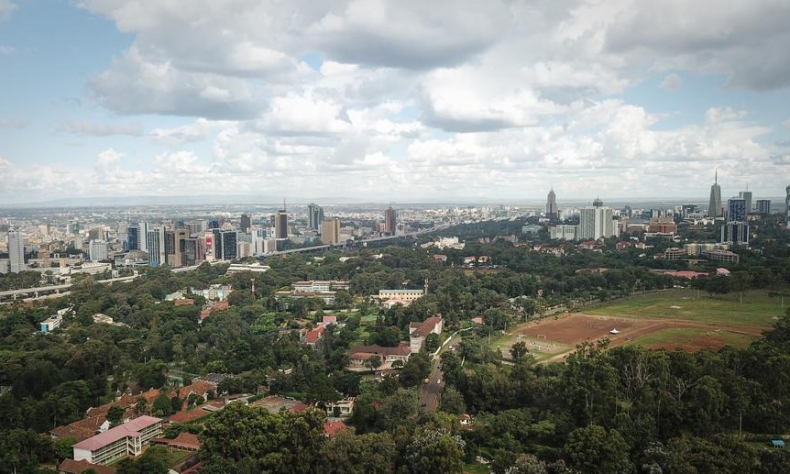Green Roofing Takes Off

Chinese solar power roof tiles assist Kenya in its 2030 renewable energy goal.
Phillip Katuve, a landlord who owns a six-storey apartment complex in Kileleshwa, an upmarket Nairobi suburb, embraced green roofing two years ago. His building now boasts a vibrant rooftop garden with integrated solar panels, supplying energy to all 24 units.
“Initially, the idea sounded expensive, but the long-term benefits have been remarkable,” said Katuve.
“I’ve seen a 40-percent reduction in energy costs, and tenants are happier because the building stays cooler during the dry seasons. Additionally, the green roof [solar-integrated, AI-powered roofing systems] has become a talking point, [as] people want to live in a space that feels eco-friendly and innovative,” he added.
Katuve’s decision to install the green roof was partially influenced by government incentives. Kenya’s Building Code now encourages sustainable construction practices, offering tax rebates for developers adopting renewable energy solutions.
Green roofs redefine cityscapes
Kenya’s urban centres are experiencing a transformation, as green roofs redefine cityscapes. In Nairobi, Chinese companies like Hanergy and Sangobuild are at the forefront of this revolution, introducing cutting-edge building-integrated photovoltaics technology – photovoltaic materials that are used to replace conventional building materials.
Hanergy has introduced thin-film solar panels that seamlessly integrate with building roofs. Unlike conventional solar installations, these panels maintain aesthetic appeal while maximising energy generation.
According to Jason Liu, Sangobuild’s project manager, the company’s AI systems analyse weather patterns, energy consumption trends, and maintenance needs.
“Our technology ensures that every rooftop becomes an efficient power generator, reducing dependency on the national grid. This approach aligns with Kenya’s goal of achieving 100 percent renewable energy by 2030,” said Liu.
Meanwhile, Aden Duale, Kenya’s cabinet secretary for environment, climate change and forestry, underscores the importance of adopting technologies that address both environmental and economic challenges.
“Green roofs are more than an architectural trend; they symbolise Kenya’s commitment to reducing carbon emissions and enhancing energy efficiency. Collaborating with countries like China to introduce AI-powered solar technology positions Kenya as a renewable energy leader in Africa,” said Duale.

New wave of sustainable architecture
Green roofs are multi-functional systems that combine vegetation and solar panels, powered by AI to optimise energy usage. Sangobuild has already installed over 300 green roofs in the city’s neighbourhoods, including Kileleshwa, Westlands, and Kilimani.
Nazra Nanda, a representative of the Kenya Green Building Society, elaborates on the dual benefits of these installations. “Green roofs mitigate urban heat by absorbing sunlight, [thereby] reducing the temperature of buildings by up to 6 degrees Celsius. Simultaneously, AI optimises solar power generation, enabling households to save on electricity bills while contributing to environmental sustainability.”
Duale points out that the government is committed to scaling up such projects. “Kenya’s renewable energy policies aim to reduce reliance on non-renewable sources while fostering innovation. We are exploring subsidies for green building materials and technologies, including AI-powered solar roofing systems, to make them more accessible to developers and homeowners.”
The Ministry of Environment, Climate Change and Forestry has also partnered with international organisations to fund green infrastructure projects. In 2024, a $10 million grant from the United Nations Development Programme was allocated to support green roofing initiatives across Nairobi and Mombasa.
Challenges and opportunities
Despite the promising benefits, adopting green roofs comes with challenges. High initial installation costs deter many developers, while a lack of awareness about the technology limits its adoption.
“The government and private sector need to invest in education and training,” said Nanda, adding that workshops and pilot projects can demonstrate the tangible benefits of green roofs.
Duale agrees, emphasising that public-private partnerships are essential. “By working with international firms like Hanergy and local organisations such as the Kenya Green Building Society, we can accelerate adoption and overcome financial and technical barriers,” according to Nanda.
Challenges haven’t stopped Nairobi’s skyline from continuing to evolve, and the integration of green roofs represents a step towards a sustainable future. Developers are beginning to see these systems not only as energy-saving solutions, but also as investments that enhance property value.
Landlord Katuve is optimistic about the potential for wider adoption. “If more landlords and homeowners understood the benefits, green roofs would become the standard, not the exception. They’re good for business, tenants, and the environment,” he said.
From mitigating urban heat to lowering energy costs, green roofs are transforming Kenya’s urban landscape into a model of sustainability. With the support of government policies, international innovation and local champions, the green roofing revolution is poised to play a key role in Kenya’s renewable energy journey.
 Facebook
Facebook
 Twitter
Twitter
 Linkedin
Linkedin
 Google +
Google +










